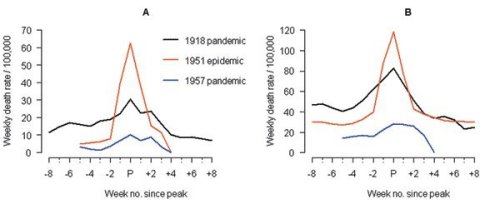Lethality is all relative if swine flu goes pandemic
I was re-reading some of my influenza texts last night (Kilbourne, Hope-Simpson, Kolata, et al), downloading swine flu data back into my head that I had not used in a couple of years. Some of the disclosures:
Swine H1N1 was actually given from humans to pigs, possibly back in Iowa in October of 1918, according to most experts. Swine H1N1 is a direct descendant of the 1918 Spanish flu bug.
Swine H1N1 is believed to have caused the mini-pandemic of 1946, where the human H1N1 was supplanted by a much more virulent version that was genetically similar to swine H1N1.
Swine H1N1 is also suspected in the 1951 epidemic of the "Liverpool flu," which predated teenaged reaction to the Fab Four by twelve years. The Liverpool flu was an extremely serious epidemic, with mortality in some areas of Britain (get this) worse than the 1918 pandemic.
Revere of Effect Measure blog wrote an excellent piece on the Liverpool epidemic back in 2007. The blog referenced a scientific paper on the epidemic, written by NIH's Cecile Viboud and her co-authors. Here is a digest:
Influenza activity started to increase in Liverpool, England, in late December 1950. The weekly death rate reached a peak in mid-January 1951 that was ~40% higher than the peak of the 1918-19 pandemic, reflecting a rapid and unprecedented increase in deaths, which lasted for ?5 weeks (see figure). Since the early 20th century, the geographic spread of influenza could be followed across England from the weekly influenza mortality statistics in the country's largest cities, which represented half of the British population. During January 1951, the epidemic spread within 2 to 3 weeks from Liverpool throughout the rest of the country.
For Canada, the first report of influenza illness came the third week of January from Grand Falls, Newfoundland. Within a week, the epidemic had reached the eastern provinces, and influenza subsequently spread rapidly westward.
For the United States, substantial increases in influenza illness and excess deaths were reported in New England from February to April 1951, at a level unprecedented since the severe 1943-44 influenza season. Much milder epidemics occurred later in the spring elsewhere in the country.
Local disparities were found in all 3 countries, with a consistent pattern of higher numbers of deaths in locations affected earlier. In England, influenza-related death rates were ~3-fold higher in Liverpool than in the rest of the country. In Canada, death rates were ~2.4-fold higher in the eastern seaboard provinces than in the rest of the country. Similarly, in the United States, rates were ~2.3-fold higher in New England than in the rest of the country.

I was also watching and listening to comments made by my friend Dr. Mike Osterholm of CIDRAP. Mike, as you can imagine, has been a very popular fellow lately. Mike reminds us all that if this virus does go pandemic, we are by no means "off the hook" in terms of lethality if the first wave is mild.
Veteran flu watchers all recall that in 1918, the spring wave of H1N1 was very mild. It was the second wave -- cooked in the summer and fall of 1918, in the trenches of WWI -- where the virus gained its ability to kill by the millions. And it was the third wave that incapacitated President Wilson (NOT a stroke, but Spanish Flu in April 1919) that allowed the punitive actions of Britain and France against aggressor Germany to move forward, and sowed the seeds for the Third Reich. That is your history lesson for today.
A swine pandemic was feared by experts long before the 1976 swine flu debacle. This is what caused the major calamity that we now call the Swine Flu Debacle. This new strain, with its curious mixture of swine, avian and human genes, is headed for an uncertain future. But we cannot simply assume that a lack of mortality or lethality is necessarily good news in the long run.

Reader Comments (1)
Awesome info! Thanks so much, Scott.